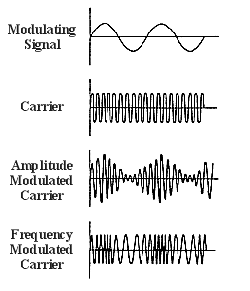
This document explores the concepts involved in radio broadcasting relevant to the community radio operator on VHF FM. We will go a step by step tour of a typical VHF FM transmitter system starting with the output from the tape recorder or mixer, and finishing with a brief discussion of aerials. At each stage we will discuss the pros and cons of various alternatives, provide additional background information and introduce the use of test equipment.
[ How to be a Community Radio Home Page | Community Radio Frequently Asked Questions and Answers]
What we are trying to is get information from one place to lots of others. I'm using information here in a wider sense, meaning speech, music, discussions on the creeping powers of the state etc, rather than phone numbers of local hairdressers or whatever. Now I'm going to assume we're going to use radio broadcasting to achieve this, which immediately rules out things like standing on top of tall buildings and shouting really loud. We'll also assume we've got this information in the form of an audio frequency signal, ie. what comes out of a tape recorder or an audio mixer. You can't transmit audio frequency signals very easily so what we do is impart the information in the audio frequency signal onto a higher frequency (radio frequency) carrier signal.
Radio frequency (RF) signals have amplitude and frequency. The frequency is how fast the signal is oscillating from one extreme to the other and back again. Frequency is measured in cycles per second (cp/s), which these days are known as Hertz (Hz). 1000Hz = 1KHz, 1,000,000Hz = 1MHz and 1,000,000,000 = 1GHz. The amplitude is to what extent the signal is oscillating. Level or Strength can be thought of as meaning the same as amplitude. Amplitude can be measured in Volts (V) or Watts (W or dBm).

Two ways of imparting our wanted information onto the RF carrier are Amplitude Modulation (AM) and Frequency Modulation (FM).
In AM the amplitude of the carrier is determined at every instant by the amplitude of the audio signal, the carrier frequency remains constant. In FM the frequency of the carrier is determined at every instant by the amplitude of the audio signal, and the carrier amplitude remains constant.
Frequencies between 30 MHz and 300MHz are known as Very High Frequencies or VHF. This corresponds to wavelengths between 10metres and 1metre. To convert between wavelength and frequency use the formula
wavelength (in metres) = 300
frequency (in MHz)
There are two sorts of FM, known as Narrow Band FM (NBFM) and Wideband FM. They differ by the maximum allowable frequency shift of the carrier when the transmitter is fully modulated. This frequency shift is known as the Deviation. Legal CB radios use NBFM with a maximum deviation of 8 kHz. Wideband FM is used by the BBC and IBA for radio broadcasting and for studio to transmitter links. The standard maximum deviation for FM radio broadcasting in the UK is 75 kHz. There is no simple way to set the deviation of a transmitter without a Deviation Meter which is an expensive piece of test gear. Probably the best way to do this is to vary the level of the audio signal going into the transmitter (TX) and listen on a receiver, until your signal sounds about the same loudness as the other broadcast stations. If you use too high a deviation you'll use a bigger than necessary chunk of the radio spectrum and most likely to cause interference to others, which will make you unpopular with the Radio Authority (responsible for policing UK airwaves).
In most countries, the FM broadcast band is between 87.5 to 108 MHz
In the UK, your broadcast frequency will be allocated by the Radio Authority, on successful processing of your license. If you are curious, you can write to the BBC or IBA's Engineering Information Offices they'll send you service maps of where their TX's are meant to be able to be heard. I dare say this information is also available on the internet.
In countries or autonomous zones with less restricted licensing conditions, you may need to choose your own operating frequencies. If your first action is to reach for your receiver and tune through looking for a blank space, think again. What stations you can receive is determined by where you are, as well as by the type and positioning of your aerial. You will need to do enough research to satisfy yourself that the frequency you intend to use is genuinely free. To do this, you will need to rely on published sources of information giving details of other known stations, as well as listening at various locations and various times of day. Armed with this information you should make a list of all frequencies in use in, say, a 30 mile radius. Then its just a question of finding a big enough gap between stations, with the proviso that your station shouldn't be nearer than 200 kHz (0.2 MHz) to the frequency of any existing station.
Now let's take a little stroll through the whole system. Click on the part in the picture you're interested in to go straight there.
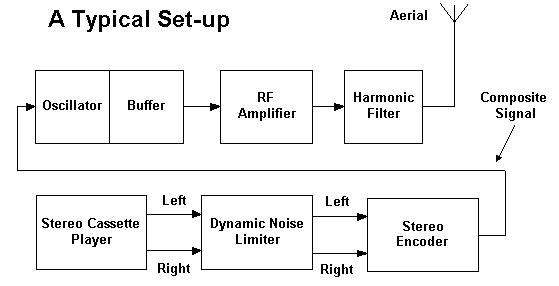
What are we going to feed into our TX? Possibilities include:
This is the simplest approach in that you can put a tape on and then continue with your law abiding business. It's also the most inflexible alternative as tapes will have to be prepared in advance. Time checks, if you're into that, will be difficult and live phone ins are right out.
Give a little thought to your choice of tape recorder, as it will probably be the weakest link in terms of sound quality. In an old clapped out one the heads will be worn flat. Maybe you can use a 'Walkman' type of player, which are small, can be battery powered, have ok quality and are cheap. The latest and greatest is to use 'Stack machines' which will change the tapes for you.
To reduce 'noise' or 'tape hiss' on such recorders, if you're doing programmes with quiet passages, you can use a circuit known as a Dynamic Noise Limiter (DNL), which is placed on the output and cuts off the 'noise' just in quiet pauses. DNLs are sometimes used in the soundtracks of old films.
The advantages of mono are that the TX is kept as simple and cheap as possible, and you don't need as much power as on stereo to get the same result. The disadvantages are you don't sound as professional. With a well-chosen stereo encoder, the listener can get quality the same as stations with a large budget. Weigh against this the extra cost, extra circuitry and more output power needed for the same signal.
What you need is a Stereo Encoder, which combines the left and right stereo signals into a single composite stereo signal which is then fed into your TX.
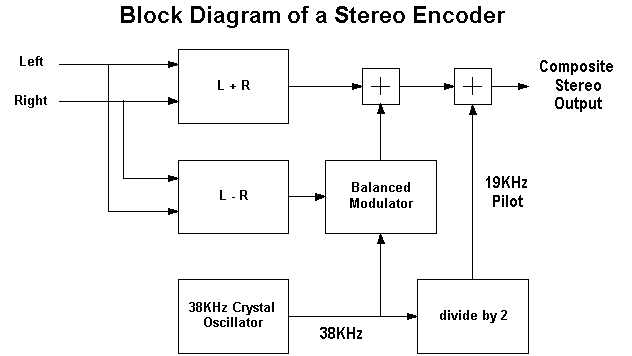
A brief technical description follows. The left (L) and Right (R) signals are fed into a summing and differential amp to get a L+R and L-R signal respectively. The L-R signal is mixed in a balanced modulator with a 38KHz sub-carrier to produce an amplitude modulated double sideband suppressed carrier signal. The 38KHz signal is derived from the same source as the 19KHz pilot tone. The composite output is formed by mixing the L+R signal, the sidebands containing the information on the L-R signal, and a bit of 19KHz pilot tone. The pilot tone switches on the Stereo Decoder in peoples' receivers, and provides a reference signal for the stereo decoder in the listener's receiver.
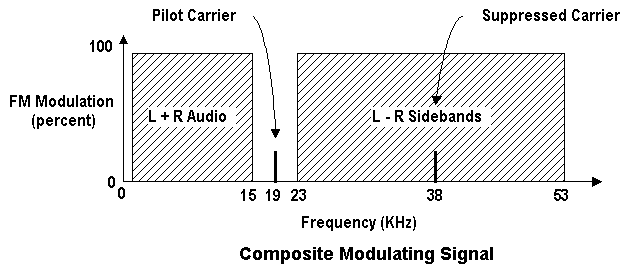
Back in the receiver, once the Stereo Decoder has extracted the L+R and L-R signal the original left and right signals are easily got by (L+R) + (L-R) = 2L and (L+R) - (L-R) = 2R.
The reason L+R and L-R signals are encoded rather than L and R is so that a mono receiver can just demodulate the L+R bit and ignore the rest of the signal. If L and R were encoded a mono receiver would only be able to hear the left channel. The 19KHz pilot tone is usually got from a crystal oscillator, to be quite accurate and stable. A crystal resonating on 4.864 MHz is convenient as 4.864 MHz divided by 2 eight times is 19 kHz. This can easily be done by digital logic chips. But its highly unlikely you'll be able to buy a 4.864MHz crystal off the shelf, so you'll have to have one made to order.
It doesn't matter if you didn't understand all of the above but one thing is important. The standard FM broadcast audio bandwidth extends only to 15 kHz. and Stereo Encoders are designed to assume this figure. If you put signals into them with frequencies above that the L+R signal and the lower side band of the L-R signal could spread into each other and you will get a right bloody mess. With a analogue tape recorder you can't really get over 15 kHz., but if you're live it is quite possible. In that case you need a low pass filter on each input to a stereo encoder. This is an audio low pass filter, not to be confused with an RF low pass filter, to be discussed later. If you're using a link between studio and TX and you want stereo you will have to know the bandwidth of the link. If it's 53 kHz. (= 38+15) or more you can use it after the encoder. Otherwise you'll need two links and have to encode at the TX end.
In a typical audio signal the high frequency sounds have less energy than the low ones and so produce less deviation of the carrier. This in turn makes them susceptible to 'noise' when received. To avoid this high frequencies are boosted before being transmitted by pre-emphasis. In the receiver the frequencies are cut by the same amount by de-emphasis So the overall frequency response of TX to receiver stays flat, but the level of background noise is reduced a lot.
Pre and Deemphasis networks are characterised by their time constant. In the USA the standard is 75 uS, but in UK it is 50 uS so anything designed or bought from there needs slight modification. In a mono TX the pre-emphasis network can be built into the front end of the exciter. For a stereo TX such a network must NOT be in the exciter or it'll play hell with the composite stereo signal from the encoder. Instead you need two networks, one for each channel, on the inputs of the stereo encoder, They're actually often built into the stereo encoder.
Compressors and Limiters operate on the same principles, but their effects and the reasons for using them are completely different.
A compressor compresses, it reduces the dynamic range of its input signal. This means as the input amplitude varies over a certain range, the output amplitude varies over only a fraction of that range. The graph shows a 2:1 compression characteristic. In this case with every change in the input amplitude the output changes only half as much. The dotted line shows a 1:1 non compressed characteristic.
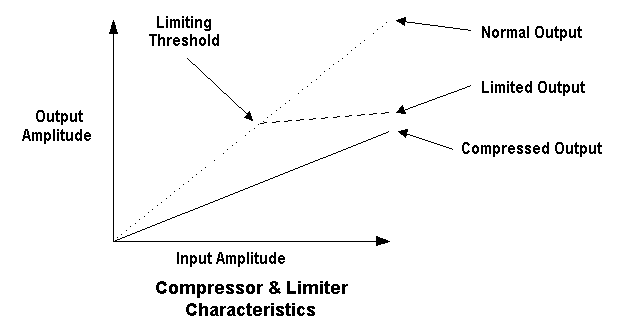
A Limiter passes its signal unaffected till the input amplitude reaches its threshold. At this point the limiter prevents the output increasing much by compressing its input much more strongly than in compressors eg 10:1.
Many stations compress their programmes to make it seem 'louder' and more 'upfront' than other stations, This occurs because the compressor keeps the average level of the signal high, even in quiet parts of the programme. The flip side of this is listeners can soon get 'listener fatigue' as constant compression can become boring and irritating to the ear, as if the music were rammed into it!
Compression has other uses, you might compress your programme as you transfer it to tape to stop quieter bits fading into background tape hiss when played. The process of recording and replaying does this to some extent anyway. Don't compress the output of a tape recorder as it'll make tape noise worse. Guitar effect units, labeled compressors, are unlikely to be much use. Compressors intended for use in home studio recording are worth experimenting with. A stereo compressor with a 2:1 characteristic can be simply constructed around a NE570 or NE571 IC. Get the data sheet in PDF format from Philips Semiconductors.
Limiters are used to stop a signal's amplitude going over a certain level. Eg. when cutting a master disc in record manufacture, large PA systems at gigs to stop loudspeakers blowing every time someone burps in a mike and, in broadcasting. In FM particularly, as the signal level increases so also does the bandwidth of the transmitted signal, risking interfering with other stations. With tape input to your TX the output is inherently limited by the recording process, so no limiter is needed. With live input to the TX it's different. Though you might set the levels right to start, along comes a loud record or voice and you could be interfering with the next station. Use a limiter.
Any limiter based on 2 back to back diodes is little more than a guitar fuzz box and will sound like one.
At the heart of everything is the Oscillator that generates the VHF signal. The frequency of this is modulated by applying an audio signal to it. The most common way of doing this is by using one or two varicap diodes. When a varicap diode is operated with a reverse bias the capacitance of the diode varies with that bias. The diode(s) is/are connected to a frequency determining part of the oscillator. The audio signal is connected across the diode to achieve frequency modulation. Also by varying the DC reverse bias the oscillator can be fine tuned. The higher the voltage, the lower the capacitance, the higher the frequency.
The VHF signal can either be generated directly, or the oscillator can oscillate on a lower frequency eg a third or half that desired and then followed by a tripler or doubler stage. There are three main types of oscillator:
These are simple oscillators which can be built round a single transistor. This can be a Bipolar Junction Transistor (BJT) or a Field Effect Transistor (FET).
The problem with these simple oscillators is that the frequency is too dependent on the temperature of the transistor - a few degrees temperature change will result in a significant change in transmitting frequency. For this reason these oscillators are unsuitable for serious or licensed use as a TX.
The transistor in the oscillator will heat itself up slightly, and other bits of the TX, like the power amps, will be fair old chucking heat out, and are usually built into the same case as the oscillator. The frequency will drift most when the TX is first switched on as all the components will be at the same temperature as the air outside the TXs case, this is known as the ambient temperature. After the TX is turned on the heat from the power amplifiers will warm the air in the case directly or indirectly. As the transistor warms the frequency will drift a bit. When heat loss from the TX equals the heat gain (generated internally) you get thermal equilibrium and the TX frequency should not drift so much. Keep your TX out of drafts to avoid messing this up. If you have a frequency counter plug in to a dummy load and see how long it takes for the frequency displayed to settle down, maybe about 15 minutes. If you have time you can arrive at the TX site early and run your TX for the warm up time with no input into a dummy load. This avoids listeners who tune in immediately having to retune as your frequency drifts.
This is also a simple oscillator but incorporates a crystal into the frequency determining network. There are various types of crystal (fundamental, 3rd overtone, 5th overtone etc) and various ways of using them (series mode, parallel mode) but their basic properties are the same. They are resonant on one frequency which is determined by the crystals characteristics when it's made. This is their problem, whereas VFOs are not very stable, crystal oscillators are too bloody stable and it's a job to get enough deviation. You'll probably lose the higher frequencies of your programme and stereo is right out. Also chances are you'll have to get a crystal made to order for your desired frequency so if you want to change it you'll need a new one. There are places which make crystals to order.
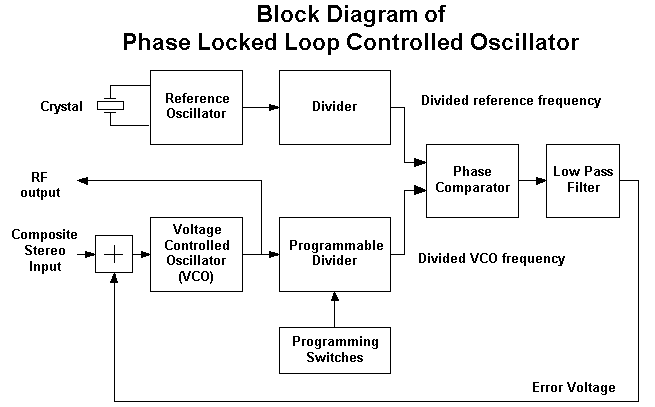
The way it's done properly is with the Phase Locked Loop oscillator. This combines the ease of tuning and wide deviation of a VFO with the frequency stability of a crystal oscillator. It works thus: A crystal oscillator is used to provide a reference frequency. This is digitally divided by logic chips to a relatively low frequency, say 25KHz. A VFO provides the wanted output frequency, which is also digitally divided to give another relatively low frequency. These two low frequencies are presented to a phase comparator which basically decides which frequency is higher by comparing the phases of the two signals. The phase comparator generates an error voltage which is connected back to the input of the VFO through a low pass filter (LPF). This is the loop bit.
If the VFO is running too fast the phase comparator decreases the error voltage so as to slow it down till the phases at its input are the same. If it's running too slow the error voltage is increased to speed it 'til the phases are the same. All this happens instantaneously, of course so the output frequency remains constant. In this way the temperature stability of the VFO isn't important and it can be built round a BJT, as its output frequency is phase locked to the crystal oscillator, and the frequency stability of this is very good. Clever eh?
Two more things to explain. How do you change the output frequency? By making the VFO's divider programmable. Say it's set to divide by the number N. The phase comparator is a simple minded sort of soul, concerned only with equalising the phases at its inputs, it doesn't know what's really coming out of the VFO, which is N times the divided reference signal. Because this signal is so low compared to the VFO frequency N can be made to have hundreds of different values, giving hundreds of different output frequencies from the VFO. So changing the frequencies is just a matter of clicking some little switches.
Hang on a sec, the VFO is being frequency modulated by the audio input, so its frequency at any given instant depends on the voltage of the audio output. We don't want this variation of the VFO's frequency to be ironed out by the PLL system so we 'iron out' the error voltage from the phase comparator, so it just contains the underlying trend rather than what's happening at any split second. This is the purpose of the low pass filter.
This system can be simplified by leaving out the dividers. If this is done you end up with an output frequency determined solely by the crystal. You've still got the wide deviation capability of course, which distinguishes this system from one based on a simple crystal oscillator. This sort of fixed frequency oscillator is used for things like wireless mikes and could be used for studio to TX links. Programmable PLL oscillators are used in all manner of professional communications equipment, including broadcast TXs.
If you can get hold of one, a frequency counter will make setting up an exciter a lot easier, as you can see what frequency you're on and whether you're drifting. You don't need to make a physical connection between the frequency counter and the circuit, in fact it's better not to. Either connect a single piece of wire to the input of the frequency counter, or use a BNC lead ending in a pair of crocodile clips clipped together to form a little loop. Frequency counters are normally sensitive enough to get a reading when the wire or loop is placed near a coil. You might get lots of other readings as you move it about. Look for a stable one near the frequency you expect (use a receiver or wavemeter if you're not sure). It's a bit of an art but you'll soon get the hang of it. For our purposes a frequency counter must have:
Any oscillator, regardless of its type, is followed by a buffer. This is usually one or two transistors operating in what is known as class A mode. Its function is to protect the oscillator from what is going on further along the circuit, especially from changes in its 'load' as the following stage is tuned. The combination of oscillator and buffer together is called the exciter and is a small but fully fledged TX. Small in respect to its output power. Typical values are in the region of 100 - 500 mW (1000mW = 1W).
To increase the power output of our fledgling TX we need to add an amplifier. Here we are talking about Radio Frequency (RF) amps, not audio amps. RF amps have certain important characteristics:
Here's a picture of a 100W amplifier stage Graphic is 24 kB
This is the range of frequencies the amplifier will amplify properly. The bandwidth is ultimately limited by the characteristics of the active devices in the amp (ie the transistors or valves) but more specifically by its type, broadband or a narrow-band amplifier.
A broadband amplifier will amplify quite a large range of frequencies and they have a good bandwidth, commonly 1.8 - 30MHz which covers all of the amateur shortwave broadcast bands - no good for a VHF operator, but could be useful for someone operating on medium wave. They operate in class A, AB or B mode and have the advantage that they don't need adjusting when the frequency is changed. Their disadvantage are they're more complex and dearer then narrow-band amps and are harder to design, requiring extensive knowledge of the transistors round which the amp is constructed.
Narrow-band amplifiers only amplify a narrow band of frequencies - they have a small bandwidth which is centred on one frequency. This frequency is determined by the tuned circuits in the input and output networks of the amplifier. Tuned circuit have a resonant frequency. This can be usually adjusted by variable capacitors known as trimmers, to the desired frequency. The amplifier will produce maximum output when the tuned circuits resonant frequency is the same as the input frequency from the exciter. Narrow-band amplifiers often operate in the class C mode, which is more efficient than class A or B. This means more of the power being drawn from the battery or whatever turns into watts up the aerial rather than heat in the amplifier.
Class C amplifiers are relatively simple circuits, and are easier to design. The bandwidth is a trade-off with gain, the wider the bandwidth the less the gain. The disadvantages of a narrow-band amp is, of course, you have to tune it to the frequency you're using, and if you change the frequency you'll have to retune to maintain the gain of the amp. Also class C amplifiers have a tendency for instability (oscillation). A little bit of bias can improve the stability substantially whilst retaining class C levels of efficiency
The power gain (as opposed to a voltage or current gain which is different) of an amplifier is defined as a ratio:
power gain = output power
input power
and is a measure of the amplifiers ability to make its input 'bigger'. Power gains are often expressed in decibels (dB) which are defined:
power gain(dB) = 10 log10 output power
input power
Amplifiers also have a maximum output power. When this is reached increasing the input power will not result in more output power and may damage the amplifier. This condition is known as saturation.
In the case of single stage (ie one transistor) class C tuned amplifier the gain and maximum output power of the amplifier is basically the gain and maximum output power of the transistor. Knowing these we can calculate the input power necessary to produce the maximum output power.
For example, lets consider the formerly popular MRF237 transistor. According to the manufacturers data sheet this has a maximum output power of 4W and a gain of 12dB. First we've to convert the gain in dB to ordinary gain using this equation:
gain = 10(gain(dB)/10)
so for our example
gain = 10(12/10) = 101.2 = 15.85
input power = output power = 4 = 0.25W = 250mW
gain 15.85
So for 4W output power we need 250mW of input power. Most exciters can manage this, hence the former popularity of the MRF237 in the 1st amplifier after the exciter. The joker in the pack is that all these figures quoted are for a frequency of 175MHz, as this is the frequency for which this transistor was designed. You can't predict what happens at 100MHz and have to experiment.
The MRF238 had 30W output power and a gain of 9dB, so it needs 3.8W input power. This can be conveniently had from the MRF237. That's how the makers (Motorola Corpse) planned it.
Here's a picture of a 5W driver with 37dB of gain Graphic is 25KB.
Impedance is the alternating current (AC) version of resistance. It, too, is measured in Ohms. The standard impedance outputs of exciters and outputs and inputs of amplifiers is 50R. The impedance of the input and the output networks of an amplifier is altered by the tuned circuits, which you recall also tune the circuit in a tuned amplifier. The input impedance is important as it effects the load the amplifier has on the stage before it. Maximum power is transferred between stages when the impedance of the output is equal to the impedance of the input. If the impedances aren't equal a mismatch is said to occur, and in this case some energy is reflected back from the input of a stage back into the output of the preceding stage, where it is wasted as heat.

The amplifier should first be tuned with reduced input power and supply voltage. Adjust the input network trimmers Cl & C2 for the best input match (lowest reading on a VSWR meter connected to the input side) and adjust the output trimmers for maximum output power. Be sure the extra power is in the frequency you want and not in the harmonics or spurious. Check with a wave meter (more of this coming up). Another VSWR meter can be used for a relative indication of the output power, or an RF Probe, will give an absolute indication. The pairs of trimmers are interdependent, adjust one and you'll have to adjust the other, and so on.
Another thing to keep a weather eye on is efficiency. This is defined as:
efficiency = RF output power
DC input power
where
DC input power = DC supply voltage * DC supply current to output stage
For a class C amplifier of more than a few watts, you'd expect an efficiency of at least 50%, preferably more like 75%. If your efficiency is less than 50% the amplifier is either badly tuned; badly designed; you're not hitting it with enough power; or something else is wrong.
Having done this and if things seem to be OK, increase the input power (by increasing the voltage supply to the previous stage) and the voltage supply slightly and repeat the tuning. Do all of this a few times until you reach the required levels. Listen in on a nearby (but not too near) receiver. The signal should be in just one place on the dial with no funny noises or modulations going on. Check with a wavemeter. Altering the trimmers and varying the input power and supply voltage should result in smooth variations of the supply current and output power with no steps or jumps. The exception is, as the input power is reduced at some point the amplifier will switch off, a characteristic of Class C amplifiers.
To vary the supply voltage you need a Variable Stabilised Power Supply Unit. If you can't get hold of one you could build one. They're not expensive and are well handy, and give you some experience, if needed, of electronic construction.
Each amplifier bumps up the power some more, because the transistor in each one can only supply so much gain. To get more power needs more gain - more transistors in more amplifiers. So if you're the proud owner of a 5 watter and you're offered a 1000W output stage, it's no good to you as you'd probably need 50W of power to drive it.
If your TX has a series of amplifiers together, you can break in between the stages to tune each one at a time. Do this by unsoldering components and soldering in short bits of coax with suitable plugs to connect to dummy load and VSWR meter.
Harmonics are multiples of the transmitting frequency. For a frequency of 100MHz, the 1st harmonic, known as the fundamental is 100MHz, The second is 200MHz, the 3rd is 300MHz etc. They are produced as side effects in various parts of the circuit, and will interfere with other users of these frequencies if they escape from the TX. This will produce Radio Frequency Interference (RFI), and won't do you any favours with the relevant authorities. Tuned class C amps don't amplify harmonics, as the harmonic frequencies are out of the range the amplifier will amplify. However the use of Class C means that harmonics are generated by the amplifier along with the desired frequency. The strongest harmonics (apart from the fundamental) from such amps are usually the 3rd, then the 5th etc. The amplitude of harmonics is minimised if the output networks are tuned properly, but they're still there. Oscillators and Buffers can also generate harmonics if they're not set up right.
To detect harmonics we need an Absorption Wavemeter usually called just a Wavemeter. Or we can use a Grid Dip Oscillator (GDO) or a Gate Dip Oscillator, both of which are known as Dip Meters. Most dipmeters have a switch which turns them into wavemeters. A wavemeter has a tuning knob, calibrated in frequency, a meter showing signal strength, and some kind of short aerial. You hold the aerial near a coil in the bit of the circuit you're interested in, and tune the wavemeter. It shows how much signal is present on the frequencies shown on the scale. So you can see what frequencies are being generated in that part of the circuit. Ideally you'll just find the fundamental, unless the circuit is a frequency tripler or something.
If you buy a wavemeter be sure it covers the right range, from below 100MHz to get the fundamental to above 300MHz to get the 3rd harmonic.
Some of you may know that we can use a VSWR meter (also known as Voltage Standing Wave Ratio meter, SWR meter or a Reflectometer) to detect mismatch between TX and the aerial, but the VSWR meter is just as much at home doing this between amplifier stages. VSWR is the ratio of the forward (or incident) and reflected power. Except for the expensive ones, the majority of VSWR meters work the same way. The switch is set to Forward or the set button is pressed. The knob is then adjusted to make the meter read full scale. The switch is then set to Reverse or the button is released. It now indicates the VSWR. A VSWR of 1:1 is perfect (no reflected power) and so unlikely. A VSWR of infinity:1 shows all the power is reflected back into the amplifier, you'll get a reading like this if the VSWR meter is connected to an amplifier output, and nothing is connected to the VSWR meters output (unless its got a built in dummy load). You'll also get this if there's a short circuit somewhere after the VSWR meter. In either case switch off immediately or you can wave goodbye to your power transistor.
The point of all this VSWR business is to get the maximum amount of power out from the amplifier into the aerial, instead of a hot TX and a bad signal.
So how do we go about tuning such an amplifier? We've got to tune it with something connected to it's output, a load, otherwise the tuning won't be right and besides the transistor will probably blow up. We could use an aerial, but this introduces an extra unknown quantity - the characteristics of the aerial. As well as the fact that we'd be broadcasting. What we need is a dummy load.
This is basically a resistor, but constructed in such a way that it presents a load to the amplifiers output independent of frequency (unlike the aerial). The three characteristics of a dummy load we're interested in are:
Dummy loads designed for the 2 meter band (a common amateur/HAM radio band, centred on 145MHz) will work well in the VHF FM band. Most test gear for this band (dummy loads, VSWR meters, power meters, wavemeters, RF voltmeters, frequency counters etc.) will work on the frequencies we're interested in.
Even if you tune everything correctly you're still going to have some harmonics generated by the last stage. A sensible operator won't let these harmonics reach the aerial. To stop harmonics reaching the aerial we need either a Low Pass Filter or a Band Pass Filter.
A Bandpass Filter (BPF) only allows through a narrow band of frequencies, ie it has a narrow bandwidth, a good one would be less than 1MHz. It needs standard 50R input and output impedance and be able to take the power you want to use. It also has to be tuned to the frequency you want let through. Other frequencies are not stopped completely, but reduced to a much lower level. It also reduces the level of the desired frequency slightly, by an amount known as the Insertion Loss. To keep this loss low, bandpass filters for high output powers are usually pretty chunky numbers.
A well-designed TX will have a filter built into it. It needs to be in a well screened case to stop harmonics leaking out. In fact your whole TX should be well screened to stop any other frequencies inside the TX finding their way out.
As an alternative to a Band Pass Filter, you could use a Low Pass Filter (LPF). This has the advantage that it doesn't necessarily have to be retuned if you change your frequency. Tune it for best match and minimum insertion loss.
As you may have guessed, you can't use any connectors at VHF as the connectors have to "match" the amplifier and feeder. Use BNC or UHF series (PL259 plug and SO239 socket). UHF is preferable for higher powers as you can get a wider cable into the plug. N type is also good but more expensive.
So you've got your nice clean harmonic-free signal coming out of your bandpass filter - we're on the home run. All that's left is to get the signal up the aerial feeder to the aerial and we're away. However, as always, there's a bit more to it than that. The aerial cable needs to match the TXs output stage at one end and the aerial at the other end. That's right, the aerial cable has a characteristic impedance as well, just like the TXs output, the connectors and the aerial, and to match this, the impedance should be 50R. As well as having the right impedance, it also got to be Low Loss or your watts will be turned into heat. This is not the same as a bad VSWR where you lose energy in the TX, a good VSWR does not necessarily mean the cable is okay. The sort of cable we're talking about is called coaxial cable or coax, which has an inner conductor totally surrounded by a circular outer sheath. Decent coax cables for short runs are UR76 and RG58U. For longer runs or higher powers use UR67. These cables are available in the UK from Maplin, amongst others.
At last, the aerial! A badly selected or built aerial can waste all the effort you have put in so far, so I recommend you read a book on aerials. I used to recommend the "The Two Metre Antenna Handbook" by FC Judd G2BCX, a paperback by Newnes Technical Books. This is now out of print, but you may get it in a library. Some of the aerials are not particularly useful for our purposes, but he covers subjects like propagation, matching and VSWR in detail. All the dimensions he gives are for the 2m amateur band centred on 145 MHz. Any other book covering the 2m radio amateur band is worth a look.
To convert designs for the 2m band to other frequencies, all dimensions (including diameter of aerial element, etc) should be multiplied by 145 and then divided by your frequency in MHz. For example 978mm for 2m becomes 978 x 145/103 = 1377mm for 103MHz.
Another decision you will have to make is what Polarisation to use. The main ones are horizontal and vertical. To simplify you can say a horizontally placed aerial produces horizontally polarised radio waves and a vertically placed one produces vertically polarised radio waves. To receive a horizontally polarised signal you need a horizontally polarised aerial, and for a vertical one a vertically polarised aerial. Most domestic hi-fi FM receivers have horizontally polarised aerials, but car aerials are vertically polarised. So what polarisation you go for depends on the audience you expect. For example on Sunday afternoon you'd expect people at home so use horizontal, whilst in rush hour you might favour vertical. You can build an aerial which splits the power between both polarisations, as used by large commercial stations, this is Mixed polarisation. But the effect of radio waves bouncing off buildings etc tends to twist the polarisation of your signal from horizontal to vertical and vice versa, so your signal will still be picked up by the other sort of aerial.
Your transmitting site will affect your choice of aerial. In the middle of the area you want to cover you'll need an Omnidirectional aerial which transmits equally all ways, while outside your coverage area you can beam the signal in, with a Directional aerial.
The simplest possible aerial for VHF is known as the Half-wave Dipole and looks like this:
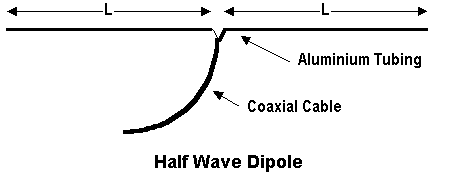
The elements can be bits of thin aluminium or copper tube. The lengths of each dipole, L, you calculate from your transmitting frequency by the formula
L = 71 metres
(f in MHz)
The impedance is about 72R, which is close enough to 50R to be fed from 50R cable without too much power loss. A half-wave dipole used vertically is omnidirectional, but when used horizontally it has a figure of eight coverage like this:
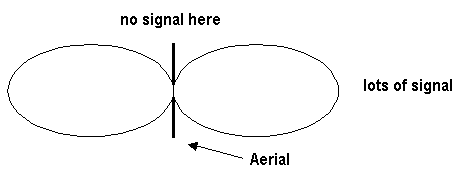
which isn't very useful. Furthermore a dipole needs a Balanced Feed as it is symmetrical, but a coaxial cable provides an Unbalanced Feed. What's needed is a Balun (BALance to UNbalance) transformer. These can be easily made out of bits of coaxial cable. If you don't do this power will be radiated from the feeder. An aerial with an impedance greatly different from 50R needs an Impedance Transformer, which can also made out of bits of coaxial cable. See an aerial book for details.
Before going on air get a low VSWR by adjusting the position of the aerial and any of it's adjustable pieces. Aim for 2:1 or less. Use low power into the aerial when tuning it up and making adjustments. If you were using 100s of watts and a bit of the aerial came off in your hand the VSWR could be so bad as to blow the final transistor. For the same reason check the DC continuity of the aerial with an ohmmeter before plugging it in, to be sure it's what it's meant to be, either a short circuit or an open one, depending on the aerial type. A dipole should be an open circuit. How to make an Weatherproof Vertically Polarised Omnidirectional Aerial
Siting is very important. Once again you can have got everything right so far, but if you fall foul with your site you're facing no listeners syndrome. The most important factor is Height. This is because VHF radio waves travel in practically straight lines. If you can see somewhere, you can transmit to it. So find somewhere with a nice view. The height of your aerial will determine how far your signal will go, while the power of your TX will determine how strong the signal is when you get there. If you run 100W into an aerial in your front room you'll produce a super signal but only your neighbours will be privileged to hear it. Conversely a 5W TX running into a good location could give you a coverage of 5 miles (8 km) or more. Keep the aerial well anyway from anything else and above any obstructions like trees and chimneys. VHF radio waves do bend a bit so you'll get a bit more coverage than you can see, but its hard to say how much.
Here's a picture of one I prepared earlier - a 100W Stereo PLL Controlled TX Graphic is 73 kB
[ Top of this Document | How to be a Community Radio Station Home Page | Introduction to Community Radio Station Electronics ]
Last updated 25 August, 2003